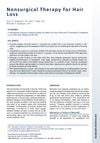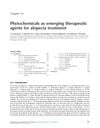TLDR Nonsurgical treatments like minoxidil and laser therapy offer various options to manage hair loss effectively.
The article reviewed various nonsurgical treatment options for patterned hair loss, which was a common condition affecting quality of life. It focused on several noninvasive treatments, including minoxidil, finasteride, dutasteride, spironolactone, low-level laser therapy (LLLT), platelet-rich plasma (PRP), microneedling, and oral supplements. These treatments were considered as first-line measures to avoid the risks and costs associated with surgical interventions. Each treatment had its own mechanism of action and varying degrees of effectiveness, providing patients with multiple options to manage hair loss without surgery.
 2 citations
,
January 2018 in “Dermatology Review/Przegląd Dermatologiczny”
2 citations
,
January 2018 in “Dermatology Review/Przegląd Dermatologiczny” Use trichoscopy to diagnose hair loss; treat with minoxidil, finasteride, or dutasteride; consider platelet-rich plasma and spironolactone.
October 2025 in “Annals of Medicine and Surgery” Retinoids may improve hair growth in androgenic alopecia when used with other treatments.
 14 citations
,
August 2013 in “Facial Plastic Surgery Clinics of North America”
14 citations
,
August 2013 in “Facial Plastic Surgery Clinics of North America” Some nonsurgical hair loss treatments are effective, especially if started early.

There are many treatments for common hair loss, but more trials are needed to decide which are best.
 13 citations
,
January 2016 in “Journal of cosmetology & trichology”
13 citations
,
January 2016 in “Journal of cosmetology & trichology” Alternative treatments show promise for hair growth beyond traditional methods.
 January 2020 in “Elsevier eBooks”
January 2020 in “Elsevier eBooks” Plant-based chemicals may help hair growth and prevent hair loss but need more research to compete with current treatments.





